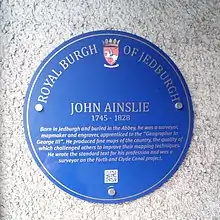John Ainslie
John Ainslie (22 April 1745 – 29 February 1828)[1] was a Scottish surveyor and cartographer.

Life
Ainslie was born in Jedburgh, the youngest son of John Ainslie, a druggist, Writer to the Signet and burgess of the burgh.[2][3] He was educated at Jedburgh Grammar School.[4] He began his career as an apprentice to the "Geographer to King George III", engraver and publisher Thomas Jefferys and worked as a surveyor and engraver for the English County series of maps.[2] After Jefferys' death he returned to Scotland where he surveyed Scottish counties, engraving and publishing the maps. His primary focus was on the coasts and islands of Scotland.[5] The quality of his maps challenged others to improve their mapping style making maps more clear and easy to read.[6]
From 1787 to 1789 Ainslie worked on a new nine sheet map of Scotland publishing it in 1789.[7] The map was a landmark in the improvement of the outline of Scotland and for the first time showed the Great Glen as a straight line and Skye, Mull, and Islay shown with more accuracy than had previously been seen.[2]
He worked as a surveyor on several civil engineering projects including the Forth and Clyde canal with Robert Whitworth, Charles Rennie on Saltcoats harbour and the Glasgow to Ardrossan canal.[2]
John was also a book-seller, which helped him in writing and publishing works of his own.[5]
He wrote the standard text for his profession, the "Comprehensive treatise on Land Surveying comprising the Theory and Practice of all its Branches".[1][8]
On 27 October 1776 he married Christian, the daughter and heiress of Jedburgh merchant Thomas Caverhill. In Edinburgh in the 1780s they lived on Parliament Square on the Royal Mile.[9]
He died at 72 Nicolson Street[10] in Edinburgh on the 29 February 1828 and is buried at Jedburgh Abbey.[2]
Other sources suggest he was married to Mary Lookup and they had two children. No dates provided.[11]
Maps
Many of Ainslie's maps are in the collection of National Library of Scotland including:
- The county of Fife published in 1775
- Scotland, drawn from a series of angles and astronomical observations..., in 9 sheets, published in 1789
- A plan of Jedburgh published in 1780
- City of Edinburgh published in 1780
- The Old and New Town of Edinburgh and Leith, 1804
- Ainslie's Map of the Southern Part of Scotland published in 1821
References
- "John Ainslie". The Gazetteer for Scotland. Retrieved 17 May 2011.
- Adams, Ian (2004). "Ainslie, John (1745–1828), cartographer and land surveyor". In Baigent, Elizabeth (ed.). Oxford Dictionary of National Biography (online ed.). Oxford University Press. doi:10.1093/ref:odnb/37098. Retrieved 5 February 2014. (Subscription or UK public library membership required.)
- "A Selection Of Famous Jedburgh People". Jedburgh Official Website. Archived from the original on 22 July 2011. Retrieved 17 May 2011.
- "Famous Sons and Daughters". Jedburgh Grammar School. Archived from the original on 27 June 2011. Retrieved 17 May 2011.
- "Cartographers". Archived from the original on 23 October 2014. Retrieved 23 October 2014.
- Ainslie, John (1789). "Scotland, drawn from a series of angles and astronomical observations..." Edinburgh: J. & J. Ainslie & W Faden. Retrieved 5 February 2014..
- Ainslie, John (1812). "Comprehensive treatise on land surveying, comprising the theory and practice in all its branches; in which the use of the various instruments employed in surveying, levelling, &c. is clearly elucidated by practical examples ..." Edinburgh: Printed for S. Doig & A. Stirling. Retrieved 5 February 2014.
- Williamson's Edinburgh Directory 1784
- Edinburgh Post Office Directory 1827
- "Ainslie, John".